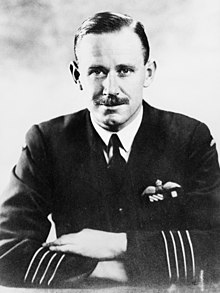John Lerew
| John Margrave Lerew | |
|---|---|

Group Captain John Lerew
|
|
| Born | 20 August 1912 Hamilton, Victoria |
| Died | 24 February 1996 (aged 83) Vancouver, British Columbia |
| Allegiance | Australia |
| Service/branch | Royal Australian Air Force |
| Years of service | 1932–46 |
| Rank | Group Captain |
| Commands held |
No. 24 Squadron (1941–42) No. 32 Squadron (1942) RAAF Station Townsville (1942) No. 7 Squadron (1942) No. 1 Aircraft Depot (1942–43) Flying Safety Directorate (1945–46) |
| Battles/wars |
World War II |
| Awards | Distinguished Flying Cross |
| Other work | Section Chief, ICAO (1946–72) |
World War II
John Margrave Lerew, DFC (20 August 1912 – 24 February 1996) was an officer and pilot in the Royal Australian Air Force (RAAF) during World War II, and later a senior manager in the International Civil Aviation Organization (ICAO). As commander of No. 24 Squadron, based in New Britain, he became famous in the annals of Air Force history for his irreverent response to orders by headquarters in Australia during the Battle of Rabaul in January 1942. After his squadron was directed to assist in repelling the invading Japanese fleet with its one serviceable bomber, and to keep its damaged airfield open, Lerew signalled headquarters with the ancient Latin phrase supposedly used by gladiators honouring their Emperor: "Morituri vos salutamus" ("We who are about to die salute you"). He also defied an order to abandon his staff, and organised their escape from Rabaul.
In February 1942, Lerew led a low-level bombing raid on enemy shipping in New Guinea that set two vessels on fire. He was shot down but managed to evade capture, and returned to safety nine days after being reported missing. Awarded the Distinguished Flying Cross, he subsequently commanded the RAAF's first flying safety directorate. After leaving the Air Force in 1946 as a group captain, Lerew took up a position with the newly formed ICAO in Canada. He was responsible for several of its administrative and technical reforms, and rose to Chief of Flight Branch in 1969. Retiring from ICAO in 1972, he travelled extensively before settling in Vancouver, where he died in 1996 at the age of eighty-three.
Born in Hamilton, Victoria, Lerew was the son of William Margrave Lerew, a chemist and veterinary surgeon who had emigrated from England with his two brothers. The family was of French Huguenot extraction, the original name being Le Roux. John Lerew was educated at Scotch College, Melbourne, where he was a member of the cadets. He studied part-time for a bachelor's degree in civil engineering at the University of Melbourne, concurrently serving approximately two years in the militia with various units including the 39th Battalion, 3rd Division Artillery Survey Unit, and Melbourne University Regiment. He also developed a love of fast cars, joining a racing team and placing third in the 1930 Australian Grand Prix.
...
Wikipedia
